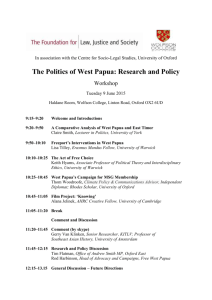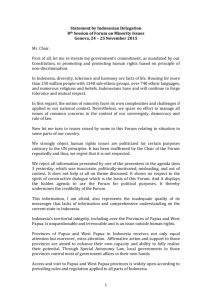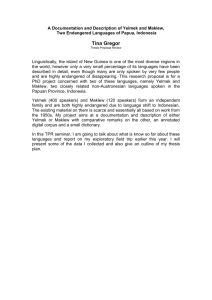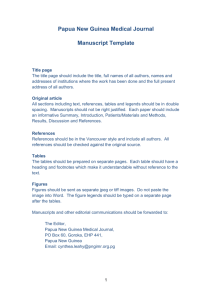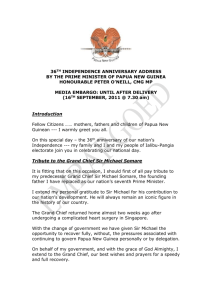Educational problems faced by West Papua
advertisement
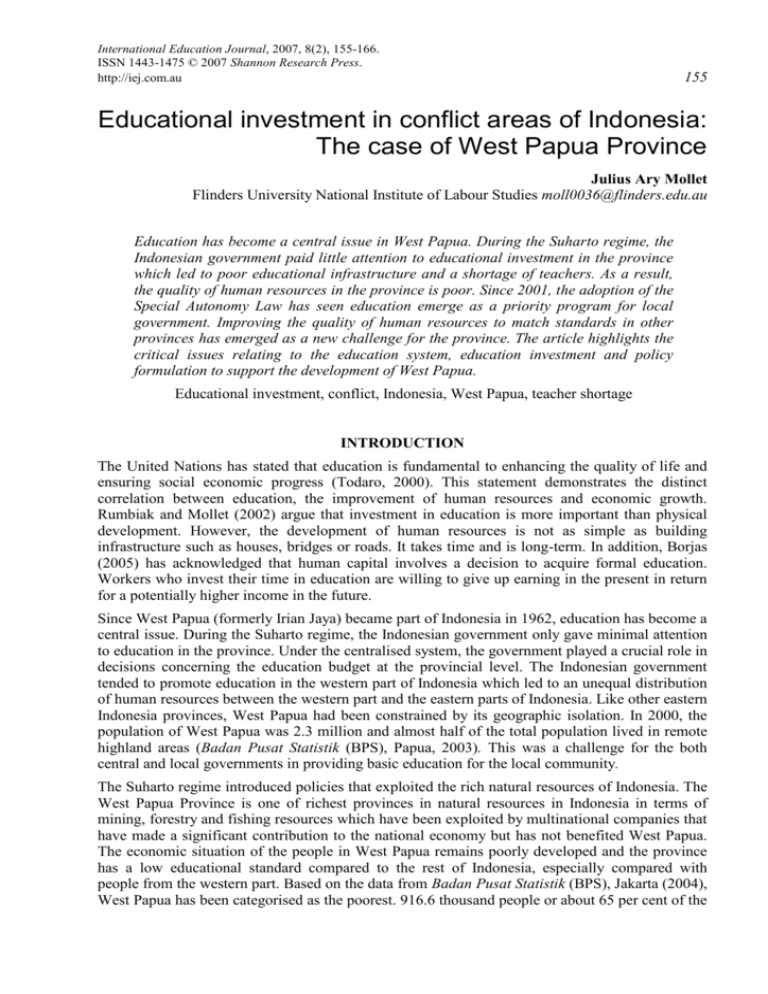
International Education Journal, 2007, 8(2), 155-166. ISSN 1443-1475 © 2007 Shannon Research Press. http://iej.com.au 155 Educational investment in conflict areas of Indonesia: The case of West Papua Province Julius Ary Mollet Flinders University National Institute of Labour Studies moll0036@flinders.edu.au Education has become a central issue in West Papua. During the Suharto regime, the Indonesian government paid little attention to educational investment in the province which led to poor educational infrastructure and a shortage of teachers. As a result, the quality of human resources in the province is poor. Since 2001, the adoption of the Special Autonomy Law has seen education emerge as a priority program for local government. Improving the quality of human resources to match standards in other provinces has emerged as a new challenge for the province. The article highlights the critical issues relating to the education system, education investment and policy formulation to support the development of West Papua. Educational investment, conflict, Indonesia, West Papua, teacher shortage INTRODUCTION The United Nations has stated that education is fundamental to enhancing the quality of life and ensuring social economic progress (Todaro, 2000). This statement demonstrates the distinct correlation between education, the improvement of human resources and economic growth. Rumbiak and Mollet (2002) argue that investment in education is more important than physical development. However, the development of human resources is not as simple as building infrastructure such as houses, bridges or roads. It takes time and is long-term. In addition, Borjas (2005) has acknowledged that human capital involves a decision to acquire formal education. Workers who invest their time in education are willing to give up earning in the present in return for a potentially higher income in the future. Since West Papua (formerly Irian Jaya) became part of Indonesia in 1962, education has become a central issue. During the Suharto regime, the Indonesian government only gave minimal attention to education in the province. Under the centralised system, the government played a crucial role in decisions concerning the education budget at the provincial level. The Indonesian government tended to promote education in the western part of Indonesia which led to an unequal distribution of human resources between the western part and the eastern parts of Indonesia. Like other eastern Indonesia provinces, West Papua had been constrained by its geographic isolation. In 2000, the population of West Papua was 2.3 million and almost half of the total population lived in remote highland areas (Badan Pusat Statistik (BPS), Papua, 2003). This was a challenge for the both central and local governments in providing basic education for the local community. The Suharto regime introduced policies that exploited the rich natural resources of Indonesia. The West Papua Province is one of richest provinces in natural resources in Indonesia in terms of mining, forestry and fishing resources which have been exploited by multinational companies that have made a significant contribution to the national economy but has not benefited West Papua. The economic situation of the people in West Papua remains poorly developed and the province has a low educational standard compared to the rest of Indonesia, especially compared with people from the western part. Based on the data from Badan Pusat Statistik (BPS), Jakarta (2004), West Papua has been categorised as the poorest. 916.6 thousand people or about 65 per cent of the 156 Educational investment in conflict areas of Indonesia: The case of West Papua Province total population earned 125,065 rupiahs as a monthly per capita salary or only about US $14 per month. As well, about 26 per cent of the total population of West Papua had not even attended primary school (Badan Pusat Statistik (BPS) Papua, 2005). West Papua was decentralised or separated from the central government in 2001 by the Special Autonomy Law (SAL). This event gave the West Papua local government personnel the authority to manage their own resources. For SAL, the most significant feature was the increased budget allocation for local government. The Governor, J.P. Salossa, in responding to decentralisation introduced four priority programs (a) education, (b) health, (c) local economy empowerment, and (d) infrastructure in response to the Special Autonomy Law (Salossa, 2006). The implementation of the Special Autonomy Law in West Papua was like shock therapy. The local government found it difficult to spend the money for proper programs such as in education. As a result, corruption and collusion occurred not only at the local government level, but also at the legislative level. According to the SAL, the local government was supposed to spend at least 30 per cent of the total budget on the education sector (Sekretariat Daerah Provinsi, Papua, 2001). This percentage was relative high when compared to Malaysia and Singapore which spent 20 to 25 per cent respectively on education. Therefore under the SAL, it has been a challenge for the local government to improve human resources in West Papua and raise them up to those of the other provinces in Indonesia. Historical and Political Contexts West Papua is situated in Eastern Indonesia bounded on the eastern border by Papua New Guinea, the north by the Pacific Ocean, the west by the Arafura Sea and the south by Australia. The physical area of Papua is 421,981 square kilometres and lies between 130° – 141° East Longitude and 2°25’ South Longitude – 9° North Longitude. The regency of Merauke has the largest area with 119,749 square kilometres while the City of Jayapura has the smallest area with 940 square kilometres. The province of West Papua consists of 27 regencies and 2 municipalities. The name of West Papua has changed many times. During Dutch colonial times the island was called Netherlands New Guinea. When the Indonesian government assumed control the island was renamed Irian Jaya (Garnaut and Manning, 1974). When Irian Jaya was decentralised in 2001, the name Irian Jaya changed to Papua. Recently West Papua was divided into two provinces namely Papua and West Irian Jaya. The capital city of Papua is Jayapura and the capital of West Irian Jaya is Manokwari. The West Papua topography consists of three areas namely the Bird Head, Central highland including the Northern and the Southern Jayawijaya highlands. According to Koentjoroningrat (1994) the Bird Head area includes Manokwari, Fak-Fak, Teminabuan, Stenkool, Kaimana, Kokas, Ayamaru and Windesi. The Central Highland and the Northern areas include Jayawijaya, Mambramo, Cenderawasih Bay and Jayapura. The area south of Mount Jayawijaya is Merauke. Historically, West Papua was colonised by the Dutch from 1828 to 1961. During the Dutch period, Papuan infrastructure was dominated by the mining sector after crude oil was discovered in Sorong. Garnaut and Manning (1974) reported that during 1951 to 1952 Papua exported 259 tons of oil equal to a value ofUS$2.460 thousands. The agricultural sector provided the second largest export commodity. Products such as copra, nutmeg, mace, crocodile skins and copal were exported to Singapore and the Netherlands, about 3,986 tons in total with a value of US$788 thousand. In 1898, the Netherlands New Guinea government expanded its administrative office to Manokwari, Fak-Fak and Merauke. As a result, government expenditure was huge because the government hired administrative officials from both Europe and Papua. In 1961, the government hired 28,000 indigenous employees from Jayapura, Manokwari, Biak, Merauke and Sorong. The number of European and Asian employees in Papua was about 15,500 and 16,600 respectively Mollet 157 (Garnaut and Manning, 1974). Moreover, wide disparities appeared in the Papua labour market in 1957. For example, unskilled labour wages were US$50 per month, an apprentice earned US$57 per month, school teachers US$65 per month and teachers with training or a diploma qualification US$124 per month. Garnaut and Manning (1974) argued that wages in Papua were higher compared to wages in other Indonesia provinces. Under Dutch colonisation, the Protestant and Catholic churches played crucial roles in educating Papuans. To support the education system in West Papua, both the Protestants and Catholics established foundations. The foundations still exist today and are managed by the Protestant Educational Foundation (YPK) and the Catholic Educational Foundation (YPPK). The northern coastal area was influenced by the Protestants while the south of West Papua was predominately influenced by Catholic missions. Many Papuans received a Christian education from primary to high school. The subjects the Dutch offered were vocational; for example, farming, fishing and motor mechanics. The Dutch educated Papuan basically aimed to establish pan-Papuan leadership in order to combat the nationalist propaganda of President Sukarno in the early 1960s (McGibbon, 2004). West Papua was incorporated into Indonesia in 1963. Subsequently the Indonesian government changed the administrative structure and economic system of Papua with the Indonesian central government assuming control. The central government controlled matters such as agriculture, social welfare, health, education and culture, and public works. During the past three decades under the Suharto regime, the central Indonesian government observed indigenous rights when developing West Papua. For example, the government provided 3.82 million hectares of land for PT Freeport Indonesia by using land belonging to the Amugngme and Komoro tribes which meant the Amugngme tribe had to move to other places (Amiruddin and De Soares, 2003). The Indonesian government grossly exploited the natural resources while paying little attention to the development of the local community. Moreover, in terms of revenue sharing, under the centralised system, the West Papua province received only a small percentage of shared revenue, while the central government enjoyed 85 per cent of revenue obtained by exploiting Papua’s natural resources such as oil (Mollet, 2002). In addition, one multinational company; PT Freeport Indonesia was the largest Indonesian taxpayer. In 1997, the mining company contributed up to 12 per cent (US$28 million) of the total Indonesian taxation revenue (Leith, 2001). The administration of West Papua has changed since 21 November 2001, when the Indonesian Government (Jakarta) offered West Papua the Special Autonomy Law (SAL) status providing for decentralisation. There have been three implications of decentralisation for West Papua. The first relates to power sharing between the central government and the local West Papuan government. Before West Papua adopted decentralisation; the province was controlled by the central government. All decisions about West Papuan development were made in Jakarta. At times decisions seemed to be in contradiction with the policies of the local government. Now the local government has more opportunity to make decisions when managing their own resources. The second issue is related to revenue sharing between the central and local government whereby the local government receives a large proportion of the shared revenue compared to the central government. The third is the recognition of indigenous peoples’ rights. To implement these rights, West Papua has founded a Peoples’ Assembly (MRP) where the membership consists of indigenous Papuan leaders, members of the religious communities, and women representatives. An Overview of Education in West Papua The educational situation in West Papua in the 1970s was very poor. The lack of school facilities and teachers were the major obstacles to the improvement of the education system in West Papua. To address the anticipated teacher shortages in Papua, the Indonesian government supplied teachers from Java. As a result, massive numbers of primary school teachers migrated to West Papua. The education system was changed from the Dutch system to an Indonesian model. It 158 Educational investment in conflict areas of Indonesia: The case of West Papua Province should be noted that the Dutch used an anthropological model for education which focussed on knowledge within the Papuan context. The Indonesian government introduced a national education system, where teachers acted as pioneers in the improvement of the quality of education in the province. As shown in Figure 1, the proportion of West Papua population who are were five years of age and over that never attended school or completed primary school was substantial and significant (about 36 per cent); those who completed primary school around 27 per cent; completed junior high school (JHS) and senior high school (SHS) about 16 per cent and 18 per cent respectively; meanwhile only two per cent completed tertiary education. These figures suggested that in 2004, skilled human resources in West Papua remained low due to the small percentage of the total population five years of age over who had completed tertiary education. Univesity, 1.17% DI/II, 1.17% Never/not yet attained prmary school, 35.63% General SHS, 17.56% General JHS, 16% Primary school, 27.32% Figure 1. Population aged five years and over by educational attainment in West Papua (2004) (Source: Computed data collected from Statistik Kesejahteraan Rakyat Provinsi Papua (Badan Pusat Statistik Papua, 2005) There was uneven distribution of schools within regencies in West Papua. In the cities such as Jayapura, Sorong and Biak there were sufficient education facilities from primary to university levels of education. In remote areas such as Jayawijaya, Pegunungan Bintang and Puncak Jaya, however, there were few primary, secondary or high schools. The lack of teachers also was a major issue for the highland area of the province. As a result, there was a high proportion of people who had not attended or not yet completed primary school. The Welfare Survey indicated that in 2004, in Jayawijaya the number of people who had not attended or not yet completed primary school was about 51 per cent, meanwhile Puncak Jaya and Pegunungan Bintang there were around 49 per cent and about 40 per cent respectively ( BPS, Papua, 2005). The growth in primary schools during the 1970s was almost double and secondary schools sixfold (Manning and Rumbiak, 1989). Moreover, between 1985 and 1986 the total number of primary schools reached 1,886; secondary schools 235 and there was one university (UNPD and Indonesian Government, 1989). However, in 2000, the total of schools in West Papua increased significantly. Data from Department of Education in Papua reported that the total number of primary schools was 2.472, secondary schools 395, high schools 115 and vocational schools 30 (Dinas Pendidikan dan Pengajaran, Papua, 2001). In 2003, there were about 2,400 primary schools, 380 secondary schools, 140 high schools and 10 tertiary institutions or universities (BPS, Papua, 2004). The West Papua enrolment rate remained below the national average. However, the enrolment rate from 1997 to 2003 fluctuated. The economic crisis in 1997-98 affected the enrolment rate in the province and resulted in a five per cent decrease in student numbers. After the province adopted the SAL in 2001, the enrolment rate in both primary school and secondary schools increased to 78 per cent and 50 per cent respectively. Furthermore, by 2001, about 96 per cent of Mollet 159 students finished primary school and continued on to secondary school (The World Bank and Papuan Government, 2005). EDUCATIONAL PROBLEMS FACED BY WEST PAPUA Shortage of Teachers A teacher shortage particularly at the primary and secondary levels in West Papua meant that not all school-aged children attended school. The Indonesian government recruited teachers from West Papua and other parts of Indonesia with limited success. It was common in remote areas for army and police personnel who were stationed in the area to give technical assistance by teaching in schools. Teachers are reluctant to teach in remote areas for the following reasons; the first is the lack of facilities and social services such as adequate housing for teachers and limited health care (Puskemas). Teachers often live in houses that belong to local people and it is very hard for teachers if they want to bring their families to the remote area. There are no social services in some highland areas of the province due to a lack of Puskesmas and medical staff. The second is a lack of transportation. It is common for teachers who work in remote areas to use small engine planes where there are only flights to remote area every three months or more. The third is lack of incentives for teachers to work in remote areas. It should be noted cost of living in remote area is expensive compared to that in urban areas. Therefore, without additional incentives for teachers in remote areas, they cannot survive. The last reason is irregular salary payments to teachers in remote areas. They must go to the regency centre to obtain their salary every three to six months, and improper accounting procedures means there is often a salary shortfall (Rumbiak and Mollet, 2002). In addition, surveys from the International Foundation for Election System (IFES) have shown that 35 per cent of 3,450 respondents mentioned a lack of an adequate of number of teachers (IFES, 2003). A significant example of this issue is noted in Bomamani-Pania, where the Catholic primary school has 180 students with three teachers each teaching six classes (UNDP and Government of Indonesia, 1989). Curriculum Like other provinces in Indonesia, the West Papua educational system has adopted the National Education System. This means the educational curriculum has been produced by the Ministry of Education in Jakarta and is a national curriculum. This curriculum is a controversial issue for educational experts in West Papua as the standard of curriculum is not designed for rural conditions. This curriculum is an urban standard curriculum designed for areas such as Jakarta, Yogyakarta or Surabaya. As a result, it is not surprising that West Papuan students have great difficulty adjusting to this curriculum. According to UNDP the national curriculum is difficult to apply in West Papua because of the local customs and the low level of basic competence of the students concerned. The students with different ethnic and regional differences receive the same kind of educational curriculum (UNDP and Government of Indonesia, 1989). Up to now, not much has been done to adapt the curriculum and teaching methods to the local context. The Shift of Non-Indigenous Students from Public Schools to Private Schools Under the Special Automy Law (SAL), the local government has an affirmative action policy to protect minority ethnicities in all sectors including in education system. To implement the policy, the education department has a policy for the public schools to allocate 50 per cent of the places for indigenous Papuan and 50 per cent for non-Papuan students. The benefit of this policy is to give more opportunity for indigenous students to study in public schools. In reality, however, the of allocation of places to indigenous students and migrant students is uneven with 80 per cent of the places going to indigenous students and only 20 per cent to non-indigenous students. This 160 Educational investment in conflict areas of Indonesia: The case of West Papua Province policy, therefore, has reduced the opportunities for non-indigenous student to study in public schools. It should be noted that public schools in West Papua are attractive to students because of the low tuition fees. Prior to 2001, public schools in West Papua were of relatively better quality than private schools and places were occupied principally by non-indigenous students. This happened because entry to a public school was based on grades, therefore, a student needed to have a certain score or grade which was determined by the central government. Thus, if students had high grades in their previous school, they could continue to further schooling, simply because they qualified to study in public school. The process for entering private schools, however, was not as strict as for public schools. Therefore, students did not qualify to enter a public school went to private schools and most of them were indigenous students. In addition, under the SAL, the situation was reversed and public schools were more likely to be of lower quality compared to private schools. This was because many capable non-indigenous students could enrol in the public schools due to the government’s affirmative action policy. Therefore, because of this situation, the non-Papuan students preferred to study in private schools. In the Jayapura municipality, prior to decentralisation, the public senior high school (SMAN I) was the top ranked high school in Jayapura. The average score of grade of National Examination Test was relatively high compared to other high schools. Also graduates from the school could continue their study at famous universities in West Papua or other provinces such Java. Recently, the quality at SMAN I dropped because the average score of National Examination Test went below that of private senior high schools such as SMA Taruna Bhakti (Catholic mission school). Last year, one of the best students from SMA Taruna Bhakti received a scholarship to study at a famous university in Singapore. Lack of Student Motivation The majority West Papua population are involved in the traditional agriculture sector. They grow vegetable or staple food for their own consumption with some left over to sell in the traditional market. It is common in rural areas for students to help their parents look for food, grow crops, hunt and fish. In the harvest season, schools in rural areas do not open as no students are able to attend school as they are needed to help their parents. The Central Population Studies Department at Cenderawasih University conducted a survey in Tomu village in Bintuni Bay regency. In 2003 they reported that about 79 per cent of the total population dropped out of school. These students did not attend school as they were needed to help their parents with sago processing and fishing (Pusat Studi Kependudukan Universitas Cenderawasih, 2003). Low Quality Education In West Papua the number of graduates from tertiary education institutions has increased during the last decade. However, many graduates from university cannot be absorbed by the private sector due to a low demand for their qualifications. As a result, the annual unemployment rate in the province has increased significantly. For Jayapura municipality and Sorong the unemployment rate in 2004 was about 20 per cent and 15 per cent respectively (Badan Pusat Statistik, Jakarta, 2005). After completion of university studies, graduates prefer to work in Jayapura municipality. It should be kept in mind that since 2000, the business environment in West Papua has declined due to political instability. Therefore, most of university graduates have looked for opportunities to work as officers for the local government. Corruption and Collusion Like other provinces in Indonesia, corruption and collusion have occurred in the process of decentralisation in West Papua. The local government has contributed less than 14 per cent of the total budget and has a greater tendency to spend the money on infrastructure which is easily Mollet 161 corrupted by the government, legislators and business people. It is common in West Papua that the local government and members of the legislative body have a mutually beneficial relationship. The local government offers the programs, but members of legislature and businessmen also want to be involved in the programs providing educational infrastructure in West Papua. In addition, the local government designs projects to improve the human resources of the bureaucrats and members of parliament by using the mutually beneficial relationship and use the education budget to continue their studies and to take Master’s degree outside West Papua at universities such as in Gajah Mada University in Yogyakarta and Hasanuddin University in Makassar. Each term funds are allocated for 40 to 50 Master’s students. They pursue their study using incentives from the education budget. Ironically, there were no students from education institutions. Furthermore, the bureaucrats need to improve the quality of human resources. However, most of the students who are bureaucrats and are studying for Masters degrees are in top salary level and almost at retirement age. Therefore, it is useless because they cannot apply their new knowledge to improve the performance of the local government. Local Government Policy Toward Education in West Papua In terms of the employment market, education can be divided into two aspects, supply and demand. The supply side refers to the quantity of schools at all levels, from primary school to university. In terms of the demand side, Todaro (2000) argues that there are two principles which influence a person’s desire to go to school. The first is the student’s educational prospects of earning a better income in the future in the modern sector employment. The second are the educational costs that the student or the family must bear. The quality of education demanded is related to the demand for high-wage employment opportunities in the modern sector. Entry to modern sector jobs is, therefore, determined by the level of an individual’s education. In addition, Todaro (2000) also states that there are four variables that affect the amount of schooling required to gain sufficient qualifications for a job in the modern sector. The first is the wage or income differential. It should be noted that there are wide differentials in wages between jobs in the modern sector and those in the traditional sector. In the modern sector a high or low salary depends on the employee’s background and the level of education completed. On the other hand, in the traditional sector, they are no educational requirements for entry into the sector. It is argued that the wage differential between modern and traditional sectors has resulted in an increased demand for education. Therefore, there is a positive relationship between the educational demand and wages gained. The second variable is the probability of success in finding job in the modern sector. A person might get a well-paid urban job as long as he or she has higher educational qualifications than a person who does not. However, if job opportunities in urban areas are limited when there are many people trying to enter the labour market, the result is likely to lead to increasing unemployment. This assumes that there is a negative relationship between the demand for education and the current unemployment rate. The third variable is the actual cost of education. These costs refer to financial expenses of for children’s education and include tuition fees, books, clothing and other associated costs. In less developed countries (LDCs), particularly, the actual costs to poor people can become a major constraint for the education of children in school. Therefore, there is a negative relationship between the demand for education and the direct cost of education. This means the higher the tuition fees associated with the cost of education, the lower the demand for education. For example, in African countries, a family may spend more than 20 per cent of their total income per capita on the education of their children (Todaro, 2000). This is the indirect cost of education. A child’s education is an investment that involves more than just the direct cost of education because even when a child becomes productive he or she may still continue to study. At the same 162 Educational investment in conflict areas of Indonesia: The case of West Papua Province time, the child ignores the family expectation in order to get income to fulfil family needs. Like the relationship between the indirect cost and the amount of educational demand, a negative relationship is found to exist between indirect cost of education and the total educational demand. The local government in West Papua has struggled to design a strategy to develop the province in order to match the supply and demand sides of education. Every governor of West Papua has had a strategic plan to push the economic development and improve the human resources in the province. However, the strategies offered did not appear to attain their objectives. As a result, the economy and human resources in West Papua have fallen behind the rest of Indonesia. Table 1 lists the governors of West Papua and the development strategies they devised. Table 1. Development strategies of West Papua governors Governors Busiri Suryowinoto (1980-1982) Isaak Hindom (1982-1988) Barnabas Suebu (1988-1992) Yacob Pattipi (1992-1998) Fredy Numberi (1999-2000) J.P. Salossa (2000-2005) Barnabas Suebu (2006-Present) Development Strategies Development focused on law and order Exploitation of forestry Development based on micro and spatial economy Empowerment of agriculture sector such as intensification. Focus on empowerment of apparatus. Focus on education, health, empowerments of local economy, & infrastructure Enforcement of local community in villages (Source: Mollet in Kompas on www.kompas.com/kompsd-cetak/0309/07/Fokus/545218.htm and The Jakarta Post on www.thejakartapost.com/yesterdaydetail.asp?fileid=20070223.G03) As indicated in Table 1, Governor Suryowinoto had a development strategy that focused on law and order. This policy led to a massive military built up in West Papua which led to human rights abuses of the local people by the military. Hindom as the next governor of West Papua promoted exploitation of Papua natural resources such as forestry. This strategy attracted private timber companies from Jakarta to West Papua. The companies included PT. Hanurata that belonged to President Suharto. The company enjoyed concessions from local government to exploit the forest resources in West Papua. Most of the companies did not give significant support to the local community as most of the workers were hired from outside West Papua. Suebu promoted micro and spatial sector strategies. These required synchronisation programs between government departments in West Papua. However, there were barriers in applying the strategies due to lack of cooperation between the sectors. Moreover, each department established very similar programs which led to overlapping. Pattipi emphasised the agricultural sector by using the intensification approach. This approach was adopted from Java and was a controversial program because the local community found it difficult to adopt not only to the new technique but also to its utilisation in agriculture. Numberi was the Papuan governor who promoted the development of human resources in local government. Many bureaucrats from provincial and regency levels studied in universities in West Papua or outside using local government funds. However, the development of human resources in the local government was not balanced. The middle and top level bureaucratic enjoyed their study, meanwhile the bottom level remained poorly educated. Salossa was governor of West Papua from Sorong. Under Salossa’s leadership, West Papua received the Special Autonomy Law (SAL) from the central government in 2001. It was an important event for West Papua as it gave the local government the authority to manage its own resources in the development of the province. In responding to the decentralisation, Salossa introduced four priority programs, (a) education, (b) health, (c) local economic empowerment, and (d) infrastructure which involved the Special Autonomy Law. In earlier attempts to decentralise West Papua, the local government faced complaints from the regency government due to unbalanced budget allocations between the provincial government and the regency. The provincial level received 60 per cent of the total budget and the regency only received 40 per cent (Sumulle, 2003). It should be kept in mind that according to the decentralisation system, the focus of development is at the regency level, not the provincial. Therefore in 2002, Salossa invited all local regency government officials to discuss the new budget allocations and the composition of budget. Mollet 163 The meeting produced new budget allocations which gave 60 per cent to regency government and 40 per cent to provincial government and continues into the present. The implementation of the Special Autonomy Law in West Papua was like ‘shock therapy’. The local government found it difficult to spend the money on proper programs. As a result, corruption and collusion occurred not only at the local government level but also in the legislature. It was common for the local government officers and members of legislature to have a mutually beneficial relationship. The local government offered the programs, but legislative members also wanted to be involved in the programs, just like businessmen. Governor Suebu was elected in 2006. Suebu established four agendas for the development of West Papua. The first was to promote good governance by adopting a new public budgeting system and improving the quality of local government from provincial and district levels. The second was to improve the welfare of the local community’s health and nutrition, education local economies and infrastructure by providing a block grant of 100 million rupiahs for each village and supervisor (The Jakarta Post, February 23, 2007). The third was to promote West Papua as peace zone and a human rights area. The last was to improve the infrastructure and transportation systems with the provision of one trillion rupiahs. As mentioned earlier Special Autonomy Law (SAL) has promoted four program priorities; education, health, economic local empowerment and infrastructure. Thus far, the West Papuan educational policy is still based on the national educational policy. However, in terms of providing a budget for educational facilities, under Chapter 56 of the SAL, the Local Government Act is obliged to allocate 30 per cent the total budget to education programs (Republik Indonesia, 2001). The local government budget in education has introduced free basic education, provided incentive courses for indigenous students, provided scholarships, and refurbishment of school buildings. Education Investment in West Papua Under the SAL education is a priority program for improving human resources in the province. This is an opportunity for the local government to develop the education section like in other provinces in Indonesia. The proportion of the budget must be 30 per cent of the total budget and should be allocated and properly used for education. Therefore, the local government needs to be very careful in selecting the educational programs for West Papua. Educational Investment in Primary School and Junior and Senior High School The implication of SAL particularly in education would seem to be more beneficial to the bureaucrats and parliament members. The vast majority of the education budget is spent on improving the human resources of local government officers and members of parliament. As mentioned earlier the local government and the legislature had planned for bureaucrats and members of parliament to take Master’s degrees as sandwich programs at Gajah Mada University and Hasanuddin University between the years 2002-04. It seemed that the local government was wasting the money for the provision of some funds to educate the bureaucrats and legislators. The money could have been used to provide libraries for primary or secondary schools or improving teachers by sending them on short training courses, to undertake exchange study, or to attend national or international conferences. In order to build a strong foundation in education, local government should provide adequate school facilities such as libraries. At present, many primary schools still do not have libraries. The motivation for students to read is very low partly due to the lack of the libraries. The price of books in West Papua is relatively high; therefore the students are not able to buy books. Libraries play a crucial important role in supporting the teaching and learning processes at school. In addition, education in West Papua is dependent on money from the central government and the 164 Educational investment in conflict areas of Indonesia: The case of West Papua Province amount of money available is not sufficient to maintain school buildings. As a result, many schools in the urban and rural areas of West Papua remain poor. The SAL has insufficient funds to upgrade the conditions in the schools in West Papua. Investment in Educational Institutions West Papua has Cenderawasih University which is located in Jayapura. The Faculty of Education at Cenderawasih University has played an important role in providing qualified teachers from primary to high school. So far, the faculty has been dependent on the central government budget. The faculty has struggled to improve the quality of lecturers despite a lack of funds. Therefore, the university has been unable to send lecturers to study for Master’s or doctoral degrees. Some of lecturers have only completed study at the undergraduate level. In addition, public schools that have been supported by the local government budget have been able to give some training to teachers to improve their ability to teach. However, private schools, which are managed by Catholic and Christian foundations (YPPK and YPK) in the remote areas of West Papua also have limited budgets to improve the training of primary and secondary teachers. Actually, those teachers have played a crucial role in students’ education in remote areas. Therefore, it is essential to provide all teachers with short training course in order to improve their teaching performance in the classroom. Educational Investment in Teachers A shortage of teachers in remote areas has been a crucial issue in West Papua. This problem can be solved if the local government focuses on investing in the improvement of resources for primary and secondary school teachers. Therefore, local government should provide scholarships for capable indigenous students to study in school or university for advanced certificates and degrees. Capable indigenous students are disadvantaged because non-indigenous teachers who work in remote areas have problems adjusting to the living in the remote areas. After a capable indigenous student has completed his or her study at university, they should return to their hometown to teach in the local primary or secondary schools. Therefore, in order to attract school teachers to work in remote areas, the local government should provide a house and some monetary incentives. This is the only way to reduce shortage of teachers in West Papua. Future Curriculum As mentioned above, the national educational curriculum was not designed for the local context. Therefore the local curriculum should be applied and focus on real things like an orientation program involving linking and matching. The majority of the people in West Papua work in agriculture, therefore the education curriculum should be related to this sector. It should be noted that during the Dutch colonial era, the educational curriculum matched the job opportunities in the West Papua labour market. This was partly due to the focus of the curriculum on the local context. The Dutch prioritised mathematics, biology, Dutch and English at primary school which were taught three times a week for 45 minutes per class. This model effectively prepared the students to continue their study at vocational secondary schools and high schools. After completing their study, they could go directly into work in the private sector such as in oil exploitation or as Dutch government officers. In addition, the national curriculum that is not relevant to real life should not be applied in West Papua. Subjects such as history need to be combined with national and local history. To make this a reality, the central and local governments should work together with the central and local educational experts to design a new form of curriculum that fulfils the needs of students in West Papua. Mollet 165 CONCLUSIONS Under the centralisation system the education situation in West Papua has been poorly developed. The lack of teachers has been the major barrier to the development of the education system in the province due to the limitation of funds from the central government. Despite the implementation of the Special Autonomy Law, education needs greater consideration. The local government is misdirecting monetary investment in the educational sector. The West Papuan government prefers to give benefits to bureaucrats and members of parliament rather than to educational institutions. Furthermore, the affirmative action policy that applies in the education sector does not encourage competition among students at school due to an imbalance in the proportion of indigenous and non-indigenous students. In addition, educational investment in West Papua should focus on investing funds in educational institutions in projects such as providing and up-grading libraries, providing short term training for teachers and scholarships for the pursuit of higher certificates and degrees, adjusting the curriculum and preparing capable indigenous students to become qualified and well educated teachers. REFERENCES Amiruddin, A. R. and De Soares, A. J. (2003). Perjuangan Amungme Antara Freeport dan Militer. Jakarta: ELSHAM. Badan Pusat Statistik, Jakarta (2004). Survei Sosial Ekonomi National. Jakarta: BPS-Jakarta. Badan Pusat Statistik, Papua (2004). Papua Dalam Angka 2003. Jayapura : BPS-Papua. Badan Pusat Statistik, Papua (2005). Statistik Kesejahteraan Rakyat Papua 2004. Jayapura : BPSPapua. Borjas, J. G. (2005). Labor Economics, (Third Edition). New York: McGraw-Hill Companies. Dinas Pendidikan dan Pengajaran, Papua (2001). Laporan Tahunan Department. Pendidikan Nasional 1999/2000, Jayapura. Garnaut, R. and Manning, C. (1974). The transformation of a Melanesian economy Canberra: Australian University Press. International Foundation for Election System (IFES) (2003). Papua Public Opinion Survey Indonesia. Jakarta: IFES. Koentjoroningrat (1994). Irian Jaya Membangun Masyarakat Majemuk, Penerbit Djambatan, Jakarta. Leith, D. (2001) Freeport trouble future, inside Indonesia. (Online) http://www.insideindonesia.org [retrieved 14 December 2006]. Manning, C. and Rumbiak, M. C. (1989). Economic development migration labour and indigineous welfare in Irian Jaya 1970-84. Canberra: National Centre for Development Studies, Research School of Pacific Studies ANU. McGibbon, R. (2004). Plural Society in Peril: Migration, Economic Change, and the Papua Conflict, Policy Studies 13, East-West Center Washington, Washington. (Online) http://www.eastwestcenter.org/stored/pdfs/PS013.pd [retrieved 14 December 2006]. Mollet, J. A. (2002). District budget collection of West Papua Province; rapid assessment for conservation economics, Jayapura:Conservation International Indonesia.. Mollet, J. A in Kompas, September 07, 2003, Kesejahteraan Warga Papua Tak Pernah Terbangun. (Online) http://www.kompas.com/kompas-cetak/0309/07/Fokus/545218.htm [retrieved 15 December 2006]. Pusat Studi Kependudukan Universitas Cenderawasih (2003). Studi Tentang Aktivitas Penduduk di Kawasan Teluk Bintuni. Jayapura: PSK-Uncen. Republik Indonesia (2001). Undang-Undang 21 Tahun 2001 Tentang Otonomi Khusus Bagi Provinsi Papua, Jakarta. 166 Educational investment in conflict areas of Indonesia: The case of West Papua Province Rumbiak, M. C. and Mollet, J. A. (2002). Investasi Pendidikan untuk Pembangunan di Provinsi Papua, Paper Presented at the University Network Symposium on Special Autonomy: Challenges and Opportunities for Economic Growth and Equity, 20 – 21 May 2002 Novotel Coralia Benoa Bali , organised by Institutional Reform and Informal Sector at The University of Maryland. Salossa, J. P. (2006). Otonomi Khusus, Papua ; Mengangkat Martabat Rakyat Papua di Dalam NKRI. Jakarta : Pustaka Sinar Harapan. Sekretariat Daerah Provinsi, Papua (2001). Undang-Undang Republik Indonesia Nomor 21 Tahun 2001 tentang Otonomi Khusus Bagi Provinsi Papua, Sekretariat Daerah Provinsi Papua, Jayapura. Sumulle, A. (2003). Mencari Jalan Tengah Otonomi Khusus Provinsi Papua, PT. Gramedia Pustaka Utama, Jakarta. The Jakarta Post (February 23,2007) ‘Sleeping giant’ Papua unveils major development programs. (Online) http://www.thejakartapost.com/yesterdaydetail.asp?fileid=20070223. G03 [retrieved 25 March 2007]. The World Bank and Papuan Government (2005). Papua public expenditure analysis; Regional finance and service delivery in Indonesia’s most remote region, World Bank, Jakarta. (Online) http://siteresources.worldbank.org/INTINDONESIA/Re [retrieved 15 December 2006]. Todaro, M. P. (2000). Economic Development, (Seventh Edition). New York: Addison-Wesley. UNDP and Government of Indonesia (1989). Regional development planning for Irian Jaya: Education and Training, Jakarta: Lavalin International and PT Hasfarm Dian Konsultan. IEJ IEJ
